

Albrecht Dürer: Biography & Painter. Renaissance is Albrecht Dürer (1471-1528).
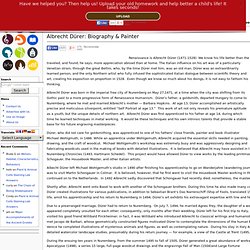
We know his life better than the lives of other artists of his time. The chandelier females - Albrecht Durer. Das Lüsterweibchen This artwork is in the public domain.
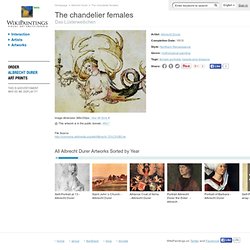
Why? All Albrecht Durer Artworks Sorted by Year. Albrecht Durer: Muzzle of a Bull. File:Albrecht Dürer - Melencolia I (detail).jpg. File:Durer lions (sketch).jpg. The Little Owl by Albrecht Dürer - ArtinthePicture. Dürer's Rhinoceros. The rhinoceros[edit] The first known print of the rhinoceros is a rather primitive woodcut which illustrates a poem by Giovanni Giacomo Penni published in Rome in July 1515.
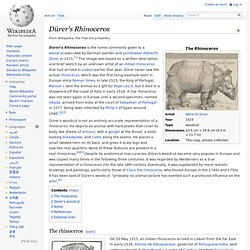
(Biblioteca Colombina, Seville). On 20 May 1515, an Indian rhinoceros arrived in Lisbon from the Far East. In early 1514, Afonso de Albuquerque, governor of Portuguese India, sent ambassadors to Sultan Muzafar II, ruler of Cambay (modern Gujarat), to seek permission to build a fort on the island of Diu. The mission returned without an agreement, but diplomatic gifts were exchanged, including the rhinoceros.[7] At that time, the rulers of different countries would occasionally send each other exotic animals to be kept in a menagerie. After a relatively fast voyage of 120 days, the rhinoceros was finally unloaded in Portugal, near the site where the Manueline Belém Tower was under construction. Dürer's woodcut[edit] The German inscription on the woodcut, drawing largely from Pliny's account,[13] reads: Albrecht Dürer (1471–1528) Dürer's Magic Square. Dürer's magic square is a magic square with magic constant 34 used in an engraving entitled Melancholia I by Albrecht Dürer (The British Museum, Burton 1989, Gellert et al. 1989).
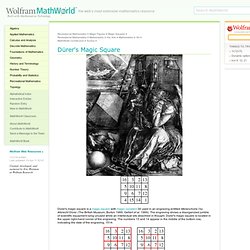
The engraving shows a disorganized jumble of scientific equipment lying unused while an intellectual sits absorbed in thought. Dürer's magic square is located in the upper right-hand corner of the engraving. The numbers 15 and 14 appear in the middle of the bottom row, indicating the date of the engraving, 1514. Albrecht Durer - The complete works. Dürer, Albrecht. Timeline: Northern Renaissance I hold that the perfection of form and beauty is contained in the sum of all men. -- Dürer, Four Books on Human Proportions, 1528 Dürer, Albrecht (b.
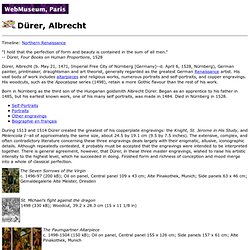
May 21, 1471, Imperial Free City of Nürnberg [Germany]--d. April 6, 1528, Nürnberg), German painter, printmaker, draughtsman and art theorist, generally regarded as the greatest German Renaissance artist. His vast body of work includes altarpieces and religious works, numerous portraits and self-portraits, and copper engravings. Born in Nürnberg as the third son of the Hungarian goldsmith Albrecht Dürer. During 1513 and 1514 Dürer created the greatest of his copperplate engravings: the Knight, St. The Seven Sorrows of the Virgin c. 1496-97 (200 kB); Oil on panel, Central panel 109 x 43 cm; Alte Pinakothek, Munich; Side panels 63 x 46 cm; Gemaldegalerie Alte Meister, Dresden St.
Albrecht Dürer. Dürer's introduction of classical motifs into Northern art, through his knowledge of Italian artists and German humanists, has secured his reputation as one of the most important figures of the Northern Renaissance.

This is reinforced by his theoretical treatises, which involve principles of mathematics, perspective and ideal proportions. Early life (1471–90)[edit] Dürer's godfather was Anton Koberger, who left goldsmithing to become a printer and publisher in the year of Dürer's birth and quickly became the most successful publisher in Germany, eventually owning twenty-four printing-presses and having many offices in Germany and abroad. Koberger's most famous publication was the Nuremberg Chronicle, published in 1493 in German and Latin editions. It contained an unprecedented 1,809 woodcut illustrations (albeit with many repeated uses of the same block) by the Wolgemut workshop. Wanderjahre and marriage (1490–94)[edit] First journey to Italy (1494–95)[edit] A List Of Animals And Their Meaning Like the title says. ANIMALS, BIRDS, AND INSECTS AND THEIR MEANINGS.
AARDVARK - a tendency to hide from problems ABOMINABLE SNOWMAN - denotes spiritual truths that are not easily accepted ALLIGATOR - spiritual aspects that are self-serving, can denotes a person who attacks out of nowhere, people who lie in wait and then attack, a person with vicious speech which is destructive ANT - denotes cooperation with others APE - cautions against loss of individuality, pretending to be someone who you are not, aping someone, being a copycat instead of your true self.

A symbol of malice and ugliness. BABOON - immaturity or lack of individuality. BADGER - denotes a person with a 'nagging' personality, usually one who interferes with another's life.